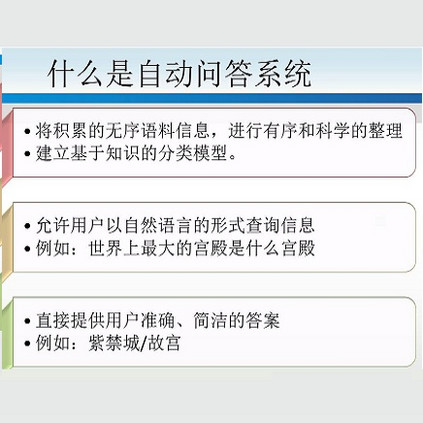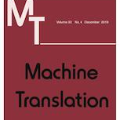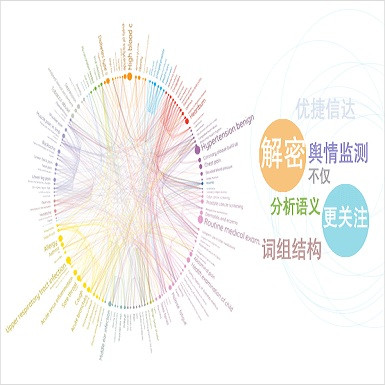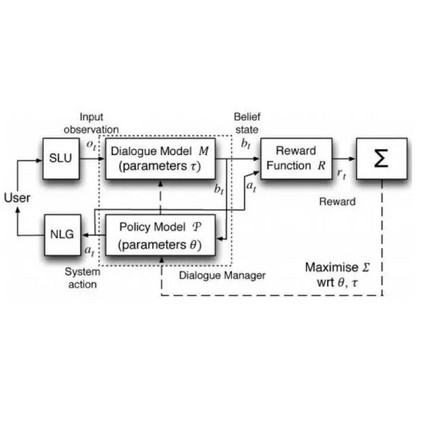(精品干货)ACL 2018最新论文归类(最全最细)分享
ACL 2018(56th Annual Meeting of the Association for Computational Linguistics)将于2018年7月15-20在澳大利亚墨尔本召开,会议的Accept的论文也早已经Releas出来。
ACL作为自然语言处理方面的顶级会议之一,其中很多工作代表了NLP的前沿方向,因此,其中很多文章非常值得学习和借鉴,今天按照一定的主题,跟大家分享一下2018年ACL的最新论文。主要分类一下14个方向整理(个人观点,仅供参考)
Dialogue and Interactive Systems(对话及交互系统)
Question Answering, QA(问答)
Generation(文本生成)
Information Extraction and Text Mining(信息抽取及文本挖掘)
Document Analysis(文档分析)
Sentence-level Semantics, Word-level Semantics(段落级、词级语义分析)
Sentiment Analysis, Argument Mining(情感分析,论点挖掘)
Summarization(摘要生成)
Tagging, Chunking, Syntax and Parsing(标记,分块,语法分析及解析)
Vision, Robotics, Multimodal, Grounding and Speech(视觉,多模态,语音等相关)
Textual Inference(文档推理)
Discourse and Pragmatics(论述及语用学)
Social Media(社交媒体)
Machine Translation(机器翻译)
Dialogue and Interactive Systems
(对话及交互系统)
sequicity: simplifying task-oriented dialogue systems with single sequence-to-sequence architectures. wenqiang lei, xisen jin, min-yen kan, zhaochun ren, xiangnan he and dawei yin.
learning to ask questions in open-domain conversational systems with typed decoders. yansen wang, chenyi liu, minlie huang and liqiang nie.
sequicity: simplifying task-oriented dialogue systems with single sequence-to-sequence architectures. wenqiang lei, xisen jin, min-yen kan, zhaochun ren, xiangnan he and dawei yin.
mem2seq: effectively incorporating knowledge bases into end-to-end task-oriented dialog systems. andrea madotto, chien-sheng wu and pascale fung.
unsupervised discrete sentence representation learning for interpretable neural dialog generation. tiancheng zhao, kyusong lee and maxine eskenazi.
deep dyna-q: integrating planning for task-completion dialogue policy learning. baolin peng, xiujun li, jianfeng gao, jingjing liu and kam-fai wong.
an end-to-end approach for handling unknown slot values in dialogue state tracking. puyang xu and qi hu.
global-locally self-attentive encoder for dialogue state tracking. victor zhong, caiming xiong and richard socher.
learning to control the specificity in neural response generation. ruqing zhang, jiafeng guo, yixing fan, yanyan lan, jun xu and xueqi cheng.
Question Answering, QA
(问答)
denoising distantly supervised open-domain question answering. yankai lin, haozhe ji, zhiyuan liu and maosong sun.
question condensing networks for answer selection in community question answering. wei wu, xu sun and houfeng wang.
efficient and robust question answering from minimal context over documents. sewon min, victor zhong, caiming xiong and richard socher.
think visually: question answering through virtual imagery. ankit goyal, jian wang and jia deng.
multi-relational question answering from narratives: machine reading and reasoning in simulated worlds. igor labutov, bishan yang, anusha prakash and amos azaria.
multi-granularity hierarchical attention fusion networks for reading comprehension and question answering. wei wang, ming yan and chen wu.
learning to ask questions in open-domain conversational systems with typed decoders. yansen wang, chenyi liu, minlie huang and liqiang nie.
denoising distantly supervised open-domain question answering. yankai lin, haozhe ji, zhiyuan liu and maosong sun.
question condensing networks for answer selection in community question answering. wei wu, xu sun and houfeng wang.
efficient and robust question answering from minimal context over documents. sewon min, victor zhong, caiming xiong and richard socher.
think visually: question answering through virtual imagery. ankit goyal, jian wang and jia deng.
multi-relational question answering from narratives: machine reading and reasoning in simulated worlds. igor labutov, bishan yang, anusha prakash and amos azaria.
multi-granularity hierarchical attention fusion networks for reading comprehension and question answering. wei wang, ming yan and chen wu.
joint training of candidate extraction and answer selection in reading comprehension. zhen wang, jiachen liu, xinyan xiao, yajuan lyu and tian wu.
question condensing networks for answer selection in community question answering. wei wu, xu sun and houfeng wang.
joint training of candidate extraction and answer selection in reading comprehension. zhen wang, jiachen liu, xinyan xiao, yajuan lyu and tian wu.
duorc: towards complex language understanding with paraphrased reading comprehension. amrita saha, rahul aralikatte, mitesh m. khapra and karthik sankaranarayanan.
simple and effective multi-paragraph reading comprehension. christopher clark and matt gardner.
multi-passage machine reading comprehension with cross-passage answer verification. yizhong wang, kai liu, jing liu, wei he, yajuan lyu, hua wu, sujian li and haifeng wang.
joint training of candidate extraction and answer selection in reading comprehension. zhen wang, jiachen liu, xinyan xiao, yajuan lyu and tian wu.
stochastic answer networks for machine reading comprehension. xiaodong liu, yelong shen, kevin duh and jianfeng gao.
multi-granularity hierarchical attention fusion networks for reading comprehension and question answering. wei wang, ming yan and chen wu.
enhancing cloze-style reading comprehension with external common knowledge using explicit key-value memory. todor mihaylov and anette frank.
denoising distantly supervised open-domain question answering. yankai lin, haozhe ji, zhiyuan liu and maosong sun.
question condensing networks for answer selection in community question answering. wei wu, xu sun and houfeng wang.
efficient and robust question answering from minimal context over documents. sewon min, victor zhong, caiming xiong and richard socher.
think visually: question answering through virtual imagery. ankit goyal, jian wang and jia deng.
multi-relational question answering from narratives: machine reading and reasoning in simulated worlds. igor labutov, bishan yang, anusha prakash and amos azaria.
multi-granularity hierarchical attention fusion networks for reading comprehension and question answering. wei wang, ming yan and chen wu.
denoising distantly supervised open-domain question answering. yankai lin, haozhe ji, zhiyuan liu and maosong sun.
question condensing networks for answer selection in community question answering. wei wu, xu sun and houfeng wang.
efficient and robust question answering from minimal context over documents. sewon min, victor zhong, caiming xiong and richard socher.
think visually: question answering through virtual imagery. ankit goyal, jian wang and jia deng.
multi-relational question answering from narratives: machine reading and reasoning in simulated worlds. igor labutov, bishan yang, anusha prakash and amos azaria.
multi-granularity hierarchical attention fusion networks for reading comprehension and question answering. wei wang, ming yan and chen wu.
Generation
(文本生成)
unsupervised discrete sentence representation learning for interpretable neural dialog generation. tiancheng zhao, kyusong lee and maxine eskenazi.
gtr-lstm: a triple encoder for sentence generation from rdf data. bayu distiawan trisedya, jianzhong qi, rui zhang and wei wang.
neuralreg: an end-to-end approach to referring expression generation. thiago castro ferreira, diego moussallem, ákos kádár, sander wubben and emiel krahmer.
hierarchical neural story generation. angela fan, mike lewis and yann dauphin.
no metrics are perfect: adversarial reward learning for visual storytelling. xin wang, wenhu chen, yuan-fang wang and william yang wang.
Information Extraction and Text Mining
(信息抽取及文本挖掘)
multimodal named entity disambiguation for noisy social media posts. seungwhan moon, leonardo neves and vitor carvalho.
multimodal named entity disambiguation for noisy social media posts. seungwhan moon, leonardo neves and vitor carvalho.
dsgan: generative adversarial training for robust distant supervision relation extraction. pengda qin, weiran xu and william yang wang.
zero-shot transfer learning for event extraction. lifu huang, heng ji, kyunghyun cho, ido dagan, sebastian riedel and clare voss.
adaptive scaling for sparse detection in information extraction. hongyu lin, yaojie lu, xianpei han and le sun.
context-aware neural model for temporal information extraction. yuanliang meng and anna rumshisky.
mem2seq: effectively incorporating knowledge bases into end-to-end task-oriented dialog systems. andrea madotto, chien-sheng wu and pascale fung.
improving knowledge graph embedding using simple constraints. boyang ding, quan wang, bin wang and li guo.
entity-duet neural ranking: understanding the role of knowledge graph semantics in neural information retrieval. zhenghao liu, chenyan xiong, maosong sun and zhiyuan liu.
amr parsing as graph prediction with latent alignment. chunchuan lyu and ivan titov.
temporal event knowledge acquisition via identifying narratives. wenlin yao and ruihong huang.
towards understanding geometry of knowledge graph embeddings. chandrahas dewangan, aditya sharma and partha talukdar.
probabilistic embedding of knowledge graphs with box lattice measures. luke vilnis, xiang li, shikhar murty and andrew mccallum.
hierarchical losses and new resources for fine-grained entity typing and linking. shikhar murty, patrick verga, luke vilnis, irena radovanovic and andrew mccallum.
improving entity linking by modeling latent relations between mentions. phong le and ivan titov.
multimodal named entity disambiguation for noisy social media posts. seungwhan moon, leonardo neves and vitor carvalho.
a multi-axis annotation scheme for event temporal relations. qiang ning, hao wu and dan roth.
joint reasoning for temporal and causal relations. qiang ning, zhili feng, hao wu and dan roth.
adaptive scaling for sparse detection in information extraction. hongyu lin, yaojie lu, xianpei han and le sun.
context-aware neural model for temporal information extraction. yuanliang meng and anna rumshisky.
Document Analysis
(文档分析)
language modeling for code-mixing: the role of linguistic theory based synthetic data. adithya pratapa, gayatri bhat, monojit choudhury, sunayana sitaram, sandipan dandapat and kalika bali.
improving event coreference resolution by modeling correlations between event coreference chains and document topic structures. prafulla kumar choubey and ruihong huang.
entity-duet neural ranking: understanding the role of knowledge graph semantics in neural information retrieval. zhenghao liu, chenyan xiong, maosong sun and zhiyuan liu.
Sentence-level Semantics, Word-level Semantics
(段落级、词级语义分析)
structvae: tree-structured latent variable models for semi-supervised semantic parsing. pengcheng yin, chunting zhou, junxian he and graham neubig.
sequence-to-action: end-to-end semantic graph generation for semantic parsing. bo chen, le sun and xianpei han.
semantic parsing with syntax- and table-aware sql generation. yibo sun, duyu tang, nan duan, jianshu ji, guihong cao, xiaocheng feng, bing qin, ting liu and ming zhou.
confidence modeling for neural semantic parsing. li dong, chris quirk and mirella lapata.
coarse-to-fine decoding for neural semantic parsing. li dong and mirella lapata.
weakly supervised semantic parsing with abstract examples. omer goldman, veronica latcinnik, ehud nave, amir globerson and jonathan berant.
multitask parsing across semantic representations. daniel hershcovich, omri abend and ari rappoport.
amr dependency parsing with a typed semantic algebra. jonas groschwitz, matthias lindemann, meaghan fowlie, mark johnson and alexander koller.
accurate shrg-based semantic parsing. yufei chen, weiwei sun and xiaojun wan.
entity-duet neural ranking: understanding the role of knowledge graph semantics in neural information retrieval. zhenghao liu, chenyan xiong, maosong sun and zhiyuan liu.
character-level models versus morphology in semantic role labeling. gozde gul sahin and mark steedman.
syntax for semantic role labeling, to be, or not to be. shexia he, zuchao li, hai zhao and hongxiao bai.
amr dependency parsing with a typed semantic algebra. jonas groschwitz, matthias lindemann, meaghan fowlie, mark johnson and alexander koller.
amr parsing as graph prediction with latent alignment. chunchuan lyu and ivan titov.
what you can cram into a single $&!#* vector: probing sentence embeddings for linguistic properties. alexis conneau, germán kruszewski, guillaume lample, lo?c barrault and marco baroni.
paranmt: pushing the limits of paraphrastic sentence embeddings with millions of machine translations. john wieting and kevin gimpel.
incorporating glosses into neural word sense disambiguation. fuli luo, tianyu liu, qiaolin xia, baobao chang and zhifang sui.
incorporating glosses into neural word sense disambiguation. fuli luo, tianyu liu, qiaolin xia, baobao chang and zhifang sui.
incorporating latent meanings of morphological compositions to enhance word embeddings. yang xu, jiawei liu, wei yang and liusheng huang.
batch is not heavy: learning word embeddings from all samples. xin xin, fajie yuan, xiangnan he and joemon jose.
probabilistic fasttext for multi-sense word embeddings. ben athiwaratkun, andrew wilson and anima anandkumar.
searching for the x-factor: exploring corpus subjectivity for word embeddings. maksim tkachenko, chong cher chia and hady lauw.
a robust self-learning method for fully unsupervised cross-lingual mappings of word embeddings. mikel artetxe, gorka labaka and eneko agirre.
learning domain-sensitive and sentiment-aware word embeddings. bei shi, zihao fu, lidong bing and wai lam.
temporal event knowledge acquisition via identifying narratives. wenlin yao and ruihong huang.
Sentiment Analysis, Argument Mining
(情感分析,论点挖掘)
aspect based sentiment analysis with gated convolutional networks. wei xue and tao li.
a helping hand: transfer learning for deep sentiment analysis. xin dong and gerard de melo.
entity-centric joint modeling of japanese coreference resolution and predicate argument structure analysis. tomohide shibata and sadao kurohashi.
Summarization
(摘要生成)
a unified model for extractive and abstractive summarization using inconsistency loss. wan-ting hsu, chieh-kai lin, ming-ying lee, kerui min, jing tang and min sun.
extractive summarization with swap-net: sentences and words from alternating pointer networks. aishwarya jadhav and vaibhav rajan.
a unified model for extractive and abstractive summarization using inconsistency loss. wan-ting hsu, chieh-kai lin, ming-ying lee, kerui min, jing tang and min sun.
unsupervised abstractive meeting summarization with multi-sentence compression and budgeted submodular maximization. guokan shang, wensi ding, zekun zhang, antoine tixier, polykarpos meladianos, michalis vazirgiannis and jean-pierre lorré.
fast abstractive summarization with reinforce-selected sentence rewriting. yen-chun chen and mohit bansal.
Tagging, Chunking, Syntax and Parsing
(标记,分块,语法分析及解析)
discourse representation structure parsing. jiangming liu, shay b. cohen and mirella lapata.
amr dependency parsing with a typed semantic algebra. jonas groschwitz, matthias lindemann, meaghan fowlie, mark johnson and alexander koller.
global transition-based non-projective dependency parsing. carlos gómez-rodríguez, tianze shi and lillian lee.
stack-pointer networks for dependency parsing. xuezhe ma, zecong hu, jingzhou liu, nanyun peng, graham neubig and eduard hovy.
twitter universal dependency parsing for african-american and mainstream american english. su lin blodgett, johnny wei and brendan o'connor.
structvae: tree-structured latent variable models for semi-supervised semantic parsing. pengcheng yin, chunting zhou, junxian he and graham neubig.
sequence-to-action: end-to-end semantic graph generation for semantic parsing. bo chen, le sun and xianpei han.
semantic parsing with syntax- and table-aware sql generation. yibo sun, duyu tang, nan duan, jianshu ji, guihong cao, xiaocheng feng, bing qin, ting liu and ming zhou.
confidence modeling for neural semantic parsing. li dong, chris quirk and mirella lapata.
coarse-to-fine decoding for neural semantic parsing. li dong and mirella lapata.
weakly supervised semantic parsing with abstract examples. omer goldman, veronica latcinnik, ehud nave, amir globerson and jonathan berant.
multitask parsing across semantic representations. daniel hershcovich, omri abend and ari rappoport.
amr dependency parsing with a typed semantic algebra. jonas groschwitz, matthias lindemann, meaghan fowlie, mark johnson and alexander koller.
global transition-based non-projective dependency parsing. carlos gómez-rodríguez, tianze shi and lillian lee.
stack-pointer networks for dependency parsing. xuezhe ma, zecong hu, jingzhou liu, nanyun peng, graham neubig and eduard hovy.
twitter universal dependency parsing for african-american and mainstream american english. su lin blodgett, johnny wei and brendan o'connor.
accurate shrg-based semantic parsing. yufei chen, weiwei sun and xiaojun wan.
Vision, Robotics, Multimodal, Grounding and Speech
(视觉,多模态,语音等相关)
attacking visual language grounding with adversarial examples: a case study on neural image captioning. hongge chen, huan zhang, pin-yu chen, jinfeng yi and cho-jui hsieh.
a purely end-to-end system for multi-speaker speech recognition. hiroshi seki, takaaki hori, shinji watanabe, jonathan le roux and john r hershey.
language modeling for code-mixing: the role of linguistic theory based synthetic data. adithya pratapa, gayatri bhat, monojit choudhury, sunayana sitaram, sandipan dandapat and kalika bali.
illustrative language understanding: large-scale visual grounding with image search. jamie kiros, william chan and geoffrey hinton.
attacking visual language grounding with adversarial examples: a case study on neural image captioning. hongge chen, huan zhang, pin-yu chen, jinfeng yi and cho-jui hsieh.
Textual Inference
(文档推理)
adversarial training for textual entailment with knowledge-guided examples. dongyeop kang, tushar khot, ashish sabharwal and eduard hovy.
structvae: tree-structured latent variable models for semi-supervised semantic parsing. pengcheng yin, chunting zhou, junxian he and graham neubig.
sequence-to-action: end-to-end semantic graph generation for semantic parsing. bo chen, le sun and xianpei han.
semantic parsing with syntax- and table-aware sql generation. yibo sun, duyu tang, nan duan, jianshu ji, guihong cao, xiaocheng feng, bing qin, ting liu and ming zhou.
confidence modeling for neural semantic parsing. li dong, chris quirk and mirella lapata.
coarse-to-fine decoding for neural semantic parsing. li dong and mirella lapata.
weakly supervised semantic parsing with abstract examples. omer goldman, veronica latcinnik, ehud nave, amir globerson and jonathan berant.
multitask parsing across semantic representations. daniel hershcovich, omri abend and ari rappoport.
amr dependency parsing with a typed semantic algebra. jonas groschwitz, matthias lindemann, meaghan fowlie, mark johnson and alexander koller.
accurate shrg-based semantic parsing. yufei chen, weiwei sun and xiaojun wan.
character-level models versus morphology in semantic role labeling. gozde gul sahin and mark steedman.
syntax for semantic role labeling, to be, or not to be. shexia he, zuchao li, hai zhao and hongxiao bai.
Discourse and Pragmatics
(论述及语用学)
improving event coreference resolution by modeling correlations between event coreference chains and document topic structures. prafulla kumar choubey and ruihong huang.
entity-centric joint modeling of japanese coreference resolution and predicate argument structure analysis. tomohide shibata and sadao kurohashi.
context-aware neural machine translation learns anaphora resolution. elena voita, pavel serdyukov, rico sennrich and ivan titov.
discourse representation structure parsing. jiangming liu, shay b. cohen and mirella lapata.
Social Media
(社交媒体)
self-regulation: employing a generative adversarial network to improve event detection. yu hong, wenxuan zhou, jingli zhang, guodong zhou and qiaoming zhu.
nugget proposal networks for chinese event detection. hongyu lin, yaojie lu, xianpei han and le sun.
a stylometric inquiry into hyperpartisan news and fake news. martin potthast, johannes kiesel, kevin reinartz, janek bevendorff and benno stein.
Machine Translation
(机器翻译)
unsupervised neural machine translation with weight sharing. zhen yang, wei chen, feng wang and bo xu.
subword regularization: improving neural network translation models with multiple subword candidates. taku kudo.
forest-based neural machine translation. chunpeng ma, akihiro tamura, masao utiyama, tiejun zhao and eiichiro sumita.
attention focusing for neural machine translation by bridging source and target embeddings. shaohui kuang, junhui li, antónio branco, weihua luo and deyi xiong.
context-aware neural machine translation learns anaphora resolution. elena voita, pavel serdyukov, rico sennrich and ivan titov.
the best of both worlds: combining recent advances in neural machine translation. mia xu chen, orhan firat, ankur bapna, melvin johnson, wolfgang macherey, george foster, llion jones, mike schuster, noam shazeer, niki parmar, ashish vaswani, jakob uszkoreit, lukasz kaiser, zhifeng chen, yonghui wu and macduff hughes.
towards robust neural machine translation. yong cheng, zhaopeng tu, fandong meng, junjie zhai and yang liu.
document context neural machine translation with memory networks. sameen maruf and gholamreza haffari.
a stochastic decoder for neural machine translation. philip schulz, wilker aziz and trevor cohn.
paranmt: pushing the limits of paraphrastic sentence embeddings with millions of machine translations. john wieting and kevin gimpel.
how much attention do you need? a granular analysis of neural machine translation architectures. tobias domhan.
unsupervised neural machine translation with weight sharing. zhen yang, wei chen, feng wang and bo xu.
subword regularization: improving neural network translation models with multiple subword candidates. taku kudo.
forest-based neural machine translation. chunpeng ma, akihiro tamura, masao utiyama, tiejun zhao and eiichiro sumita.
attention focusing for neural machine translation by bridging source and target embeddings. shaohui kuang, junhui li, antónio branco, weihua luo and deyi xiong.
context-aware neural machine translation learns anaphora resolution. elena voita, pavel serdyukov, rico sennrich and ivan titov.
the best of both worlds: combining recent advances in neural machine translation. mia xu chen, orhan firat, ankur bapna, melvin johnson, wolfgang macherey, george foster, llion jones, mike schuster, noam shazeer, niki parmar, ashish vaswani, jakob uszkoreit, lukasz kaiser, zhifeng chen, yonghui wu and macduff hughes.
towards robust neural machine translation. yong cheng, zhaopeng tu, fandong meng, junjie zhai and yang liu.
document context neural machine translation with memory networks. sameen maruf and gholamreza haffari.
a stochastic decoder for neural machine translation. philip schulz, wilker aziz and trevor cohn.
paranmt: pushing the limits of paraphrastic sentence embeddings with millions of machine translations. john wieting and kevin gimpel.
how much attention do you need? a granular analysis of neural machine translation architectures. tobias domhan.
unsupervised neural machine translation with weight sharing. zhen yang, wei chen, feng wang and bo xu.
forest-based neural machine translation. chunpeng ma, akihiro tamura, masao utiyama, tiejun zhao and eiichiro sumita.
attention focusing for neural machine translation by bridging source and target embeddings. shaohui kuang, junhui li, antónio branco, weihua luo and deyi xiong.
context-aware neural machine translation learns anaphora resolution. elena voita, pavel serdyukov, rico sennrich and ivan titov.
the best of both worlds: combining recent advances in neural machine translation. mia xu chen, orhan firat, ankur bapna, melvin johnson, wolfgang macherey, george foster, llion jones, mike schuster, noam shazeer, niki parmar, ashish vaswani, jakob uszkoreit, lukasz kaiser, zhifeng chen, yonghui wu and macduff hughes.
towards robust neural machine translation. yong cheng, zhaopeng tu, fandong meng, junjie zhai and yang liu.
document context neural machine translation with memory networks. sameen maruf and gholamreza haffari.
a stochastic decoder for neural machine translation. philip schulz, wilker aziz and trevor cohn.
paranmt: pushing the limits of paraphrastic sentence embeddings with millions of machine translations. john wieting and kevin gimpel.
how much attention do you need? a granular analysis of neural machine translation architectures. tobias domhan.
unsupervised neural machine translation with weight sharing. zhen yang, wei chen, feng wang and bo xu.
forest-based neural machine translation. chunpeng ma, akihiro tamura, masao utiyama, tiejun zhao and eiichiro sumita.
attention focusing for neural machine translation by bridging source and target embeddings. shaohui kuang, junhui li, antónio branco, weihua luo and deyi xiong.
context-aware neural machine translation learns anaphora resolution. elena voita, pavel serdyukov, rico sennrich and ivan titov.
the best of both worlds: combining recent advances in neural machine translation. mia xu chen, orhan firat, ankur bapna, melvin johnson, wolfgang macherey, george foster, llion jones, mike schuster, noam shazeer, niki parmar, ashish vaswani, jakob uszkoreit, lukasz kaiser, zhifeng chen, yonghui wu and macduff hughes.
towards robust neural machine translation. yong cheng, zhaopeng tu, fandong meng, junjie zhai and yang liu.
document context neural machine translation with memory networks. sameen maruf and gholamreza haffari.
a stochastic decoder for neural machine translation. philip schulz, wilker aziz and trevor cohn.
paranmt: pushing the limits of paraphrastic sentence embeddings with millions of machine translations. john wieting and kevin gimpel.
how much attention do you need? a granular analysis of neural machine translation architectures. tobias domhan.
attention focusing for neural machine translation by bridging source and target embeddings. shaohui kuang, junhui li, antónio branco, weihua luo and deyi xiong.
two methods for domain adaptation of bilingual tasks: delightfully simple and broadly applicable. viktor hangya, fabienne braune, alexander fraser and hinrich schütze.
a stochastic decoder for neural machine translation. philip schulz, wilker aziz and trevor cohn.
unsupervised neural machine translation with weight sharing. zhen yang, wei chen, feng wang and bo xu.
forest-based neural machine translation. chunpeng ma, akihiro tamura, masao utiyama, tiejun zhao and eiichiro sumita.
attention focusing for neural machine translation by bridging source and target embeddings. shaohui kuang, junhui li, antónio branco, weihua luo and deyi xiong.
context-aware neural machine translation learns anaphora resolution. elena voita, pavel serdyukov, rico sennrich and ivan titov.
the best of both worlds: combining recent advances in neural machine translation. mia xu chen, orhan firat, ankur bapna, melvin johnson, wolfgang macherey, george foster, llion jones, mike schuster, noam shazeer, niki parmar, ashish vaswani, jakob uszkoreit, lukasz kaiser, zhifeng chen, yonghui wu and macduff hughes.
towards robust neural machine translation. yong cheng, zhaopeng tu, fandong meng, junjie zhai and yang liu.
document context neural machine translation with memory networks. sameen maruf and gholamreza haffari.
a stochastic decoder for neural machine translation. philip schulz, wilker aziz and trevor cohn.
paranmt: pushing the limits of paraphrastic sentence embeddings with millions of machine translations. john wieting and kevin gimpel.
how much attention do you need? a granular analysis of neural machine translation architectures. tobias domhan.
unsupervised neural machine translation with weight sharing. zhen yang, wei chen, feng wang and bo xu.
forest-based neural machine translation. chunpeng ma, akihiro tamura, masao utiyama, tiejun zhao and eiichiro sumita.
attention focusing for neural machine translation by bridging source and target embeddings. shaohui kuang, junhui li, antónio branco, weihua luo and deyi xiong.
context-aware neural machine translation learns anaphora resolution. elena voita, pavel serdyukov, rico sennrich and ivan titov.
the best of both worlds: combining recent advances in neural machine translation. mia xu chen, orhan firat, ankur bapna, melvin johnson, wolfgang macherey, george foster, llion jones, mike schuster, noam shazeer, niki parmar, ashish vaswani, jakob uszkoreit, lukasz kaiser, zhifeng chen, yonghui wu and macduff hughes.
towards robust neural machine translation. yong cheng, zhaopeng tu, fandong meng, junjie zhai and yang liu.
document context neural machine translation with memory networks. sameen maruf and gholamreza haffari.
a stochastic decoder for neural machine translation. philip schulz, wilker aziz and trevor cohn.
paranmt: pushing the limits of paraphrastic sentence embeddings with millions of machine translations. john wieting and kevin gimpel.
往期精彩内容推荐
模型汇总24 - 深度学习中Attention Mechanism详细介绍:原理、分类及应用
国立台湾大学-李宏毅-2017年(秋)最新深度学习与机器学习应用及其深入和结构化研究课程分享
DeepLearning_NLP

深度学习与NLP

商务合作请联系微信号:lqfarmerlq









